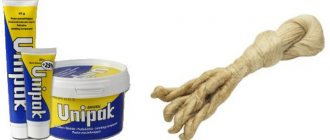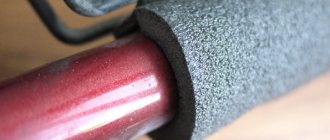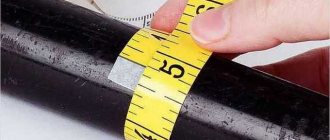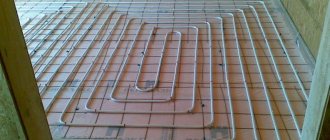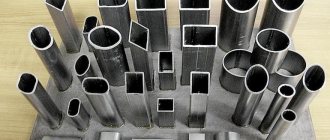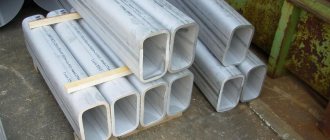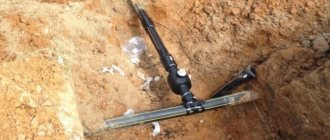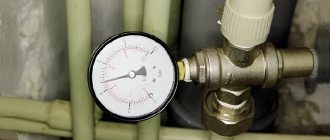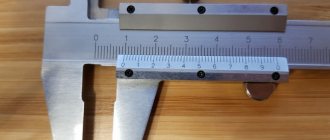Paint calculator
Painting pipes is a mandatory stage of their installation, as it significantly extends their service life and also gives them a beautiful appearance.
To perform these works, you should purchase consumables: primer and paint. How do you determine how much to buy so that it’s enough, but there’s no extra left over? After all, today high-quality primer and paint are quite expensive materials and it will be expensive to overpay for leftovers. It’s one thing when you need to paint a pipe in a house, but quite another thing when there are large volumes - for example, at a water pump or gas distribution station. To help, Azmen engineers have developed a calculator for calculating the amount of paint for painting pipes, which you can use online directly on our website - just enter the data and the program will quickly and accurately calculate the required amount of paint depending on the diameter of the pipe and its length.
The program will recalculate taking into account paint consumption per unit area - in grams per 1 linear meter (in one or two layers).
You don’t need to bother at all; you just need to specify the necessary parameters. And also, it should be noted how the coating will be applied: manual, pneumatic or airless. The calculator will do the rest.
How is paint consumption calculated?
Calculation of paint consumption is easy to calculate. Typically, on paint cans, the manufacturer indicates the average consumption per 1 m2. Knowing the pipe area (S), you can determine the figure in a particular case by multiplication. Let’s say the paint consumption is 150 g/m2, multiply this figure by the area that was previously determined.
Paint calculations are made taking into account the following criteria:
- material used in the manufacture of the pipe;
- presence of corrosion on the pipeline;
- presence of soil coverage;
- roughness.
When calculating paint consumption, not only the circumference and the relationship between the development area and the diameter are taken into account, but also the material consumption data specified by the manufacturer. In order not to make mistakes when making calculations, you can turn to specialists for help.
It is not difficult to prepare a product for painting; it is enough to carry out a number of measures, including taking into account the table of material consumption. The area determination program always calculated reliable numbers.
How to prepare and paint metal pipes (2 videos)
Pipes of different types and shapes (18 photos)
Why paint pipes?
Making a pipe look aesthetically pleasing is the most obvious function of painting. But she is far from the only one. First of all, pipes are painted to make them corrosion resistant. Previously, water pipes were made of steel without a special protective coating. This approach allowed for significant savings.
At the end of the last century, the situation was complicated by the fact that there was no control over construction companies as such. And difficult financial conditions have forced companies to resort to austerity.
Therefore, to set up utilities, the cheapest steel pipes with thin walls, which were designed for the installation of gas pipeline systems, were most often used. Such water pipelines literally fell into disrepair within ten years. Painting in this case could extend their service life.
At the moment the situation has improved, but not much. And now steel pipes are most often used in household heating and water supply systems. You can extend the service life of such structures if you carry out painting work (read: “Which paint to choose for heating pipes - possible options, characteristics”). First you need to calculate the paint for the pipe.
Recommendation: galvanized pipes do not require full painting with an anti-corrosion compound. But the threaded area needs protection, since the zinc layer on it is often destroyed. Therefore, the threads in galvanized pipes must be painted.
The principle of painting pipes
If you plan to paint cold water supply pipes, they must first be dried. First, prepare enough water to last you 24 hours. Do not open the cold tap during this time. Within 24 hours, the water supply will heat up to room temperature, and at the same time all condensation will disappear. If you plan to paint the cold water riser, you will have to use a fan to dry it. All moisture should disappear from it.
When drying is complete, you can proceed to surface preparation. Pipes must be thoroughly cleaned and degreased. Using a knife is usually all you need to remove paint to get the job done.
If it doesn't lag behind, try heating it with a hair dryer or a gas torch. But watch the temperature, overheating can lead to leakage of threaded connections. Now you will need to clean the surface with a wire brush. There should be no layers of paint or other materials left on the pipe.
You can move on to priming work, then painting begins. It is advisable to apply two layers, although then the paint consumption on the pipe will be higher. It is preferable to choose liquid paint. If it is too thick, then it needs to be diluted. Otherwise, untidy smudges will form, and such a coating will take much longer to dry.
A special case
Many people are interested in whether it is possible to paint hot pipes. Anyone can complete this task. But there are certain nuances that need to be taken into account.
Features of painting hot pipes:
- It is worth understanding that applying paint with a brush is not the best option. Since the pipe is hot, the coating will dry quickly, even before it is completely rubbed. Because of this, the painted product will look unsightly and have marks from the brush. Therefore, it is advisable to purchase spray paint. You can also use a spray gun.
- It is extremely important to calculate the painting of the pipe in advance and buy material in reserve. After all, the leftovers can be used in the future. But if there is a lack of paint, many difficulties will arise.
- The paint will emit a pungent odor when dry. Inhaling it will make a person feel unwell and will negatively affect his health. Therefore, it is advisable to think about the issue of ventilation in advance and perform work in a respirator.
- It is necessary to carefully approach the issue of choosing paint. Experts recommend using heat-resistant enamel that is resistant to high temperatures. Low quality paint will quickly change color.
Recommendation: It is highly undesirable to cover the wall with newspaper; there will most likely be smudges on it. It is best to use plastic film. It must be secured in such a way that it simultaneously grasps the section of the wall and the floor from below.
Information
After completing the installation of pipe communications, above-ground or underground pipelines, the need arises to paint the pipes. This is done to avoid corrosion and destruction of steel pipelines. The online calculator will help you calculate the area of the pipe, as well as the paint consumption for painting the pipe surface. The program will quickly and without errors determine the area to be painted on the pipe; you just need to enter the available dimensions into the calculator menu bar.
Calculator functions for calculating pipes
The pipe area calculator for painting is an online program consisting of the following blocks:
- two lines for entering pipe sizes;
- additional function “Count paint consumption”;
- two lines of output of finished calculation results;
- reference information with a pipe sketch, formula and explanation of symbols.
The pipe painting calculator allows you to calculate:
- pipe surface area;
- required amount of paint.
In addition, the finished result can be saved as a PDF file or printed with one click.
How the calculator works
To get a ready-made calculation of the pipe area and paint consumption, you need to enter the following data in the program menu lines:
- indicate the outer diameter, in mm;
- indicate the length, in meters;
To obtain the amount of paint required, you need to tick the “Calculate paint consumption” box and:
- indicate paint consumption based on the average consumption rate (i), in g/m2;
After this, the calculator will automatically produce the finished result: calculation of the pipe area in square meters; the amount of paint required in grams.
IMPORTANT! In order to use the pipeline for a long time and without repairs, several rules must be followed: remove rust, degrease the surface of the pipe, apply at least two layers of paint: base primer and main finish. You can avoid all these procedures, with the exception of degreasing, and use a special 3in1 rust paint, which includes primer, paint and a rust converter.
Pipe (water and gas) is a type of rolled metal, a long hollow welded product of round cross-section. It is used for water and gas pipelines, heating systems, as well as for the manufacture of parts for water and gas pipelines.
Source
Purpose of the calculator
Calculating the pipe area is needed when you need to know the material consumption and labor costs. Any craftsman can visually determine the area of the walls and estimate the approximate consumption, but doing the same when it comes to pipes or metal structures is much more difficult.
The area of the pipes needs to be found out if the following work is planned:
- application of anti-corrosion coating;
- decorative painting;
- applying a thermal insulation layer to large diameter pipes.
In each of these cases, you need to know the consumption of materials. If, for example, a metal structure made of a round or profile pipe is being painted, and the work is carried out by hired workers, then in order to avoid any abuse, it is worth calculating in advance the material consumption and labor costs in man-hours. This approach is beneficial to the customer and evokes respect in the eyes of the contractor.
Painting of main water pipes
Calculator for calculating pipe area for painting
Pipe painting area - features, table and recommendations
Online calculator for calculating the painting of a pipeline surface based on the outer diameter - we will independently calculate how much paint is needed to completely cover a pipeline of round, rectangular or square pipes.
Using our calculator you can make an online calculation of the surface area of a pipe for painting based on the volume of paint, determine the estimated amount of paint for the area to be painted, calculate the total area of all areas and the estimated amount of paint for the entire section of the pipeline.
What nuances should be taken into account
The calculation of the pipe surface area depends on the design of the rolled product. Most often you can see products in the form of a cylinder, but there are other types, namely:
- Square or rectangular shape. Square profiles are often found in practice.
- In the form of a cone, that is, the cross-sectional diameter is different. Such products are extremely rare.
- The surface of the pipes can also be corrugated.
- There may be cement rings for equipping sewer systems.
Types of pipes
First of all, it should be taken into account that paint consumption will be affected not only by the size of the pipes, but also by their shape, as well as the structure of the material from which they are made. So, for example, to cover smooth-walled and corrugated products of the same size, different amounts of paintwork materials will be required.
Pipes can have a wide variety of shapes and cross-sectional sizes. Depending on these parameters, the scope of operation of pipe products is determined. The most common pipes are cylindrical in shape with a round cross-section, most often used for the construction of water and gas pipelines.
A popular type of construction metal products are profile pipes with a cross-section different from round. They can be oval, square and rectangular. They are used to create structure frames, various metal structures, floors and spans.
Corrugated pipes with a round cross-section are used for the construction of underground non-pressure domestic and industrial sewerage systems and storm sewers.
There are also cone-shaped pipes. They are intended for pressure injection systems.
Where to begin
Paint consumption depends not only on the size of the pipe, but also on the material used to make it and on the shape.
Most often you can find pipes in the shape of a cylinder. But there are other types:
- In the shape of a rectangle. Outwardly, they look like ordinary timber. Otherwise called profile.
- Cone-shaped. The name speaks for itself. Very rarely used. Their scope of application is pressure injection systems.
- Corrugated.
- For sewerage equipment. They are large cement rings.
The dimensions of pipes of each type correspond to the requirements stated for them in special documents.
Tolerances for calculations
Tolerances in this type of calculation, such as material consumption, are quite significant values. In addition to the obvious factors, such as area and number of layers, consumption is also influenced by less noticeable, but no less significant:
- number of turns and bends;
- presence of welded, flanged and bolted connections;
- configuration: straight, free-standing pipes use less paint than a section with crowded pipes;
- the consumption of thick paint is much greater than that of liquid paint;
- Painting a corrugated pipe takes more time and material.
Measurements
There are two ways to calculate the volume of paints and varnishes: using a special table or using geometric formulas. In both cases, it will be necessary to make accurate measurements of the products.
If there is a table of the area of pipes to be painted, you just need to find a position in it with the same dimensional indicators as obtained during measurements, and look at the consumption of paint or primer. Calculation using formulas is a more complex, but no less effective way. To determine the painting area of pipes of a certain shape and cross-section, the appropriate formulas are used.
How to calculate the surface area of a pipe - examples of calculating external and internal area
Online calculator for calculating the painting of a pipeline surface based on the outer diameter - we will independently calculate how much paint is needed to completely cover a pipeline of round, rectangular or square pipes.
Using our calculator you can make an online calculation of the surface area of a pipe for painting based on the volume of paint, determine the estimated amount of paint for the area to be painted, calculate the total area of all areas and the estimated amount of paint for the entire section of the pipeline.
Formulas and calculation elements
To calculate the surface area, the following data is needed:
- outer diameter for round pipes;
- The calculator calculates the area of the profile pipe for painting based on the lengths of the sides;
- pipe length.
In the case of a profile pipe, everything is simple, the perimeter is simply multiplied by the total length of the pipe, the result is the surface area. To calculate a round pipe, the calculator first uses the formula to find the circumference and only then calculates the area. The calculator calculates the pipe area for painting without taking into account bends and turns; to take them into account, you need to use a tolerance factor.
The surface area of conical or corrugated pipes is not determined by the program; to calculate it, you need to increase the tolerance value to 1.3 - 1.4. After the area has been found, labor costs can be determined; to do this, you need to refer to the ENR tables.
Labor standards for painting work
Cylindrical pipes
To make calculations, you need to know the length of the pipe and its outer radius. Length is measured in meters and radius in millimeters. The following formula is used:
For example, with a pipe length of 10 m and a diameter of 60 mm, its surface area will be 1.88 square meters. meters.
The same formula is used to calculate the paint area of sewer pipes. The only difference between these designs is their large sizes. For example, the diameter of sewer wells can be 70-200 cm. In such cases, the standard height of these products is taken as a basis - 90 cm.
Calculation of cross-sectional area
The cross-section of the pipe is, subject to correct cutting, when the ends are perpendicular to the longitudinal axis of the product, a regular circle.
The area of a circle is calculated using the formula:
where π=3.1415926, R is the outer radius of the circle, D is its outer diameter.
Taking into account the thickness of the pipe walls, the pipe area is calculated using the formula:
where l is the pipe wall thickness.
If in the first formula we take R and D not as external, but as internal diameters, then there is no need to take into account the wall thickness, and the calculation can be carried out using the first equation.
You need to understand that before calculating the cross-sectional area of a pipe, all initial parameters should be converted to the same units of measurement (for more details: “How to calculate the cross-sectional area of a pipe - simple and proven methods”). In principle, if desired, calculations can be carried out in any units - millimeters, centimeters, meters, etc. The main thing when carrying out further computational operations is to bring the area value to a standard form (square meters).
It should also be taken into account that in pressure pipelines the working medium moves throughout the entire volume of the pipe, and in the case of a gravity-flow design, the liquid fills only part of the volume of the pipe - the so-called live section (about
Corrugated pipes
These types of products are the most difficult to accurately calculate their surface area because they can be stretched lengthwise. For ease of calculations, it is recommended that all values obtained during measurements be presented in writing in the form of a table.
So, you will need to set the following parameters:
- radius of curvature (A);
- projections of smooth parts onto length and diameter (B, D);
- corrugation pitch size (C);
- the angle of inclination of a flat area (E);
- height of the corrugated part (F);
- product pull line (G).
Using a specific example, let's look at how calculations are carried out. For example, value A is 3 mm. To determine the size of the rounded part, the formula 2 x π x A is used. Thus, the result is 18.84 mm. The value of D must be doubled, let it be equal to 20 mm. Taking into account the above data, it is possible to determine the length of the corrugation in stretched form - 38.84 mm.
Having removed the angle of inclination, we calculate the value of E. This indicator will be equal to twice the diameter, that is, 12 mm.
Let's assume that the length of the product is 10 m. To calculate the number of folds, divide the length by the step and get 866 pieces. Next, you need to determine the length of the corrugated pipe in the stretched state. With a diameter of, for example, 52 mm, the total area of the structure will be 54.92 square meters. meters.
How it's done
Several geometric formulas will help you calculate paint consumption. They will differ depending on the type of pipe.
Cylindrical
The area of a cylindrical product is calculated using the following formula: S = 2 * π * R * L. The quantities indicated in it are:
- π – number “pi”;
- R – outer radius of the pipe in millimeters;
- L – length in meters.
For example, if the length of the pipe is 10 m and its diameter is 60 mm, the surface area will be 1.88 m2. Calculations for commonly used pipe diameters can be found in the corresponding tables or use our calculator.
Knowing the surface area to be painted and the properties of a particular paint, you can easily determine its consumption.
Cylindrical sewer
The area of such products is calculated using the above formula. The only difference is the larger sizes. The calculation is based on a height of 90 cm. These are the rings that are most often used for sewer installations. The outer diameter can vary from 70 to 200 cm. Here are some examples:
- With a diameter of 70 cm, the area will be 1.99 m2.
- If the diameter is one meter, the area will be 2.83 m2.
- For the largest products (diameter - two meters), the surface area for painting will be 5.65 m2.
Profile
To determine the area of a profile pipe required for painting, you need to know its dimensions:
- H – height of one side;
- W – height of the other side;
- L – length.
For calculations, the following formula is used: S = 2 * H * L + 2 * W * L. If the length of the product is the same 10 meters, and its sides are 5 and 10 cm, the total area will be three square meters.
Cone shaped
For the most part, such structures are a truncated cone. The area of its lateral surface can be calculated using the following formula: S = π * (
R11+ R2
) *
L. It consists of the following quantities:
- R1 – radius of the smaller circle;
- R2 – radius of the larger circle;
- L – generatrix of a truncated cone: the length of the wall from the narrow to the wide part of the pipe.
With the structure measuring ten meters, three and six centimeters in diameter, the painting area will be almost one and a half square meters.
Corrugated
Calculating the area to paint a corrugated pipe is the most difficult thing to do. Experts recommend entering all values obtained during the work into a table.
So, first you need to decide on the following dimensions:
- rounding radius – A;
- projections of straight sections onto length and diameter (B and D);
- pitch of corrugated part – C;
- bevel angle of the flat part – E;
- height of the corrugated section – F;
- the line along which the product can stretch is G.
Essentially, a corrugated pipe is the same cylinder that can be extended along the G line.
The calculations look something like this.
- Let us assume that the value of A is 3 mm. The rounded part is calculated using the formula 2 x π x A. In this case, it will be 18.84 mm.
- The value of D must be doubled. Let it be equal to 20 mm.
- If we take into account the above data, we can determine that the stretched corrugation will be equal to 38.84 mm.
- If you remove the bevel angle, you can calculate the value of E. It is equal to twice the diameter, or 12 mm.
- As in previous cases, the length of the product is 10 m. Knowing this, you can calculate the number of folds. To do this, the length must be divided by step. It turns out 866 pieces.
- Knowing all these dimensions, you can calculate the stretched length of the product. To do this, 866 must be multiplied by 38.84 mm. It turns out that the length of the stretched corrugation will be 33.64 m.
- If the diameter of the stretched corrugation is, for example, 52 mm, the area for painting will be equal to 54.92 m2.
Why you need to know this
Below we will consider the situation, at a time when these parameters in most cases invariably need to be taken into account in work:
- Knowledge of the area formula will be necessary when calculating the heat transfer of a heated floor or heating register . Data can be taken based on a non-specialized area that transfers heat to the air in the room from a working fluid of a certain temperature.
- The second option is the opposite situation, which is also seen quite often . Especially if you need to calculate heat loss along the entire length of the pipeline to the heating device. When calculating the number and size of convectors, radiators and other devices, the instructions require you to know exactly how many calories they can produce. The data is determined taking into account the surface area of the pipeline transporting water.
- Once you know how to calculate the surface area of a pipe, you can purchase the correct amount of insulation . Often the length of the heating main is tens of kilometers, based on this, the correct data will help companies save significant funds.
- Another point is the cost of painting or anti-corrosion coating, the price of which is sometimes impressive . In this case, knowledge will allow you to accurately calculate the required amount of material. In addition, it is possible to find out indirectly the negligence of the work performers, if the costs per 1 m2 of surface increase significantly.
- Calculation of the pipe area (section) will allow you to determine the greater permeability of the product . It goes without saying that it is possible to immediately have a larger diameter, but with huge investments in construction projects, this indicator plays a significant role in cost overruns.
How to calculate the surface area of different pipes
The surface area of the pipe is determined by the formula. Circumference is one of the important geometric quantities. Calculations should be given special attention. To calculate the number of squares of metal pipelines, it is recommended to apply mathematical formulas.
Cylindrical
The calculation is determined by the following formula: S = 2 x π x R x L
π is a constant value, equal to 3.14;
R – radius of the product (in mm);
L is the length indicator (in m).
Precast concrete pipes
To calculate the paint area of cylindrical sewer pipes, the main criterion is the height indicator (H). Calculating square footage is easy using the formula above.
On the video: the volume of a cylinder and its surface area.
Profile
The area of the profile pipe is determined as follows. When calculating the appropriate squares for painting, the formula should be used: S = 2 x H x L + 2 x W x L
H and W are the heights of the two sides;
L – length of profile pipes.
Cone-shaped
It is easy to find out the number of squares for painting pipes of this type using the formula: S = 2 x π x R1 x L + π x (R1 x R1 + R2 x R2)
2 and π are constants;
R1 and R2 are the specified diameter of the smaller and larger circle;
L – denotes the length of the entire element.
Corrugated
It is most difficult to calculate how much material is needed to paint products with this type of surface. For calculations you should determine:
- The rounding radius is A. Let's say it is 3 mm. Using the formula – 2 x π x A we calculate the rounded part, it will be 18.84 mm;
- Vertical projections of length (B) and diameter (D);
- The bevel angle at the very base is E (calculated by multiplying D by 2);
- The height of the corrugation is F, and G is the stretching line of the product.
Next, you will find out the number of folds, the calculated one is obtained by division, that is, the length divided by the step. You can calculate a stretched structure by multiplying the number of folds formed by the length of the corrugation, also in a stretched state.
Calculation of the area of pipe or pipeline to be painted can be found in tables on the Internet, or you can do it yourself. The area of the outer surface of the pipe can be easily taken from reference books, according to the tables placed in them. To determine the external size of the area, you can use the base development method. The diameter obtained from the measurement can be used as a guide when calculating the radius.
Using an online calculator, you can accurately calculate the circumference and squares to be processed, both external and internal bases.
Selection of paints and varnishes
Different types of paints are used to paint pipes:
- Acrylic enamel, which contains organic solvents, providing a strong and durable glossy finish.
- Alkyd enamel is available for sale in a huge range of colors. Such paints are also characterized by durability, forming a reliable layer that does not crack or wear off.
- Water-dispersion paints. The advantages of such compositions include the ability to dry quickly and the absence of an unpleasant odor. The disadvantages are poor resistance to abrasion and water. Before using water-based paints, pipes must be coated with a primer.
- Oil paint. It is rarely used for painting pipes. Available in a small range of colors. Before painting metal surfaces, including pipes, a primer is required to ensure a strong bond with the paint. An oil-based paint composition is applied to the dried primer in at least two layers.
When choosing the type of paint for painting pipes, it is necessary, first of all, to focus on their purpose and operating conditions, since both the durability of the paint coating and the service life will depend on factors such as temperature, humidity, risk of mechanical damage, etc. service of the pipes themselves.
What and how to paint?
After the area of the surface to be painted and the material consumption have been calculated, you can select the coloring composition. The following types of paints are used for painting pipes:
- Acrylic based enamel. It contains organic solvents. A durable shiny coating is formed on the surface.
- Alkyd enamel. Features a wide range of colors. Allows you to create a durable coating that does not crack or wear off.
- Water-dispersed compositions. Dries faster than other dyes. In addition, they do not have an unpleasant odor. Before using such substances, a primer must be applied to the surface of the pipes.
- Oil paint. It is used extremely rarely for such purposes.
The first layer is to apply a primer. It will protect the surface from rust and increase the strength of the connection with the paint. After the primer has dried, apply two coats of paint.
Calculating paint consumption manually is not so easy - for this you will have to remember several geometric formulas. Before starting calculations, it is necessary to take measurements of the structure. To make the process easier, you can use ready-made tables or a pipe surface area calculator.
Heat preservation
Insulation of heating pipes reduces heat loss not only in the central line, but also in the bulk room, where the route between the heating boiler and living rooms passes through cold auxiliary rooms.
The difference between insulation materials in terms of thermal conductivity and installation method requires selection taking into account the installation location and the properties of the material. Manufacturers offer several types of insulating element:
- glass wool in cut rolls; after wrapping it around the pipe, it is tightened with wire and covered on top with aluminum foil or roofing felt;
- basalt wool in plates; installation technology similar to glass wool;
- flexible pipe made of foamed foil polyethylene with a cut along the product for installation; used for internal engineering networks;
- Liquid thermal insulation is used on already laid pipelines, when there is no room for maneuver with other materials.
- polystyrene foam in the form of two detachable pipe halves; during installation, the shell halves are put on the pipe, aligned and secured with construction tape; Foam insulation is used repeatedly.
Source

